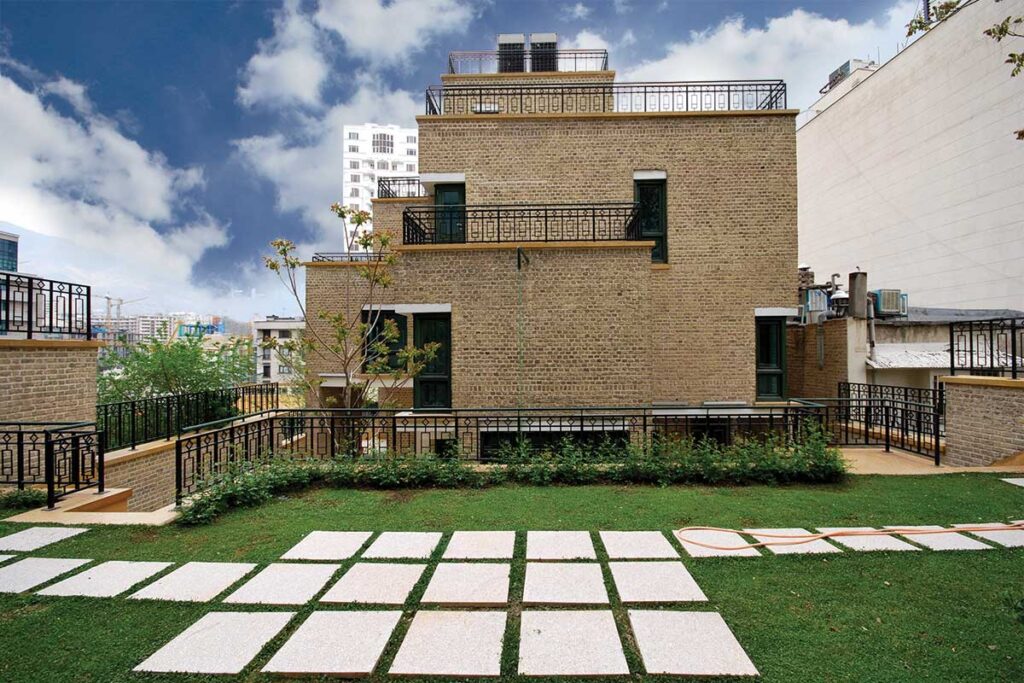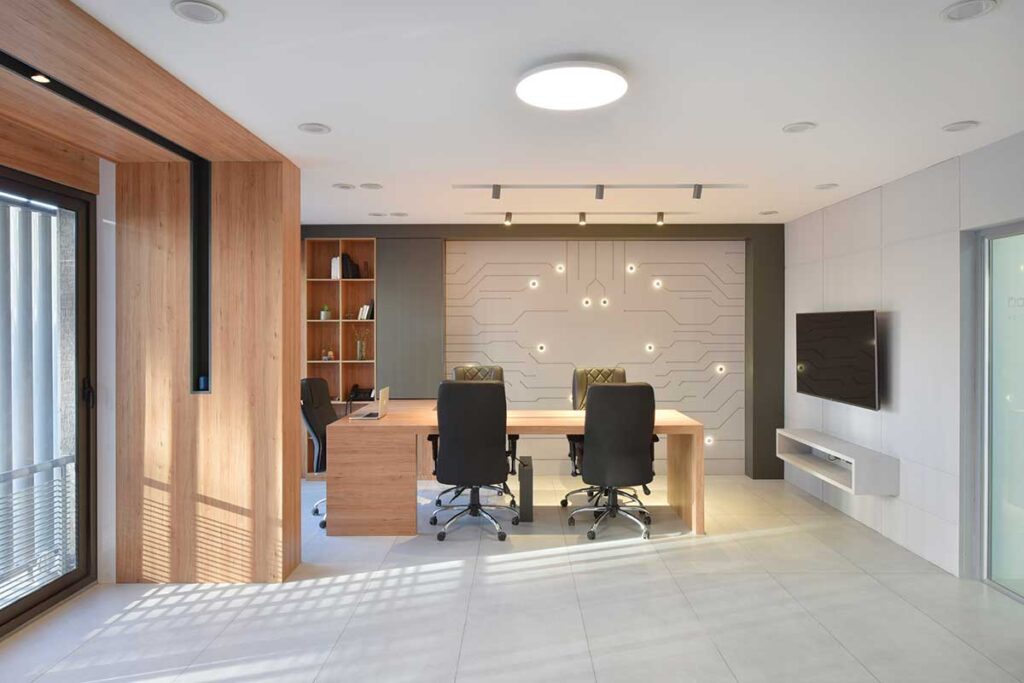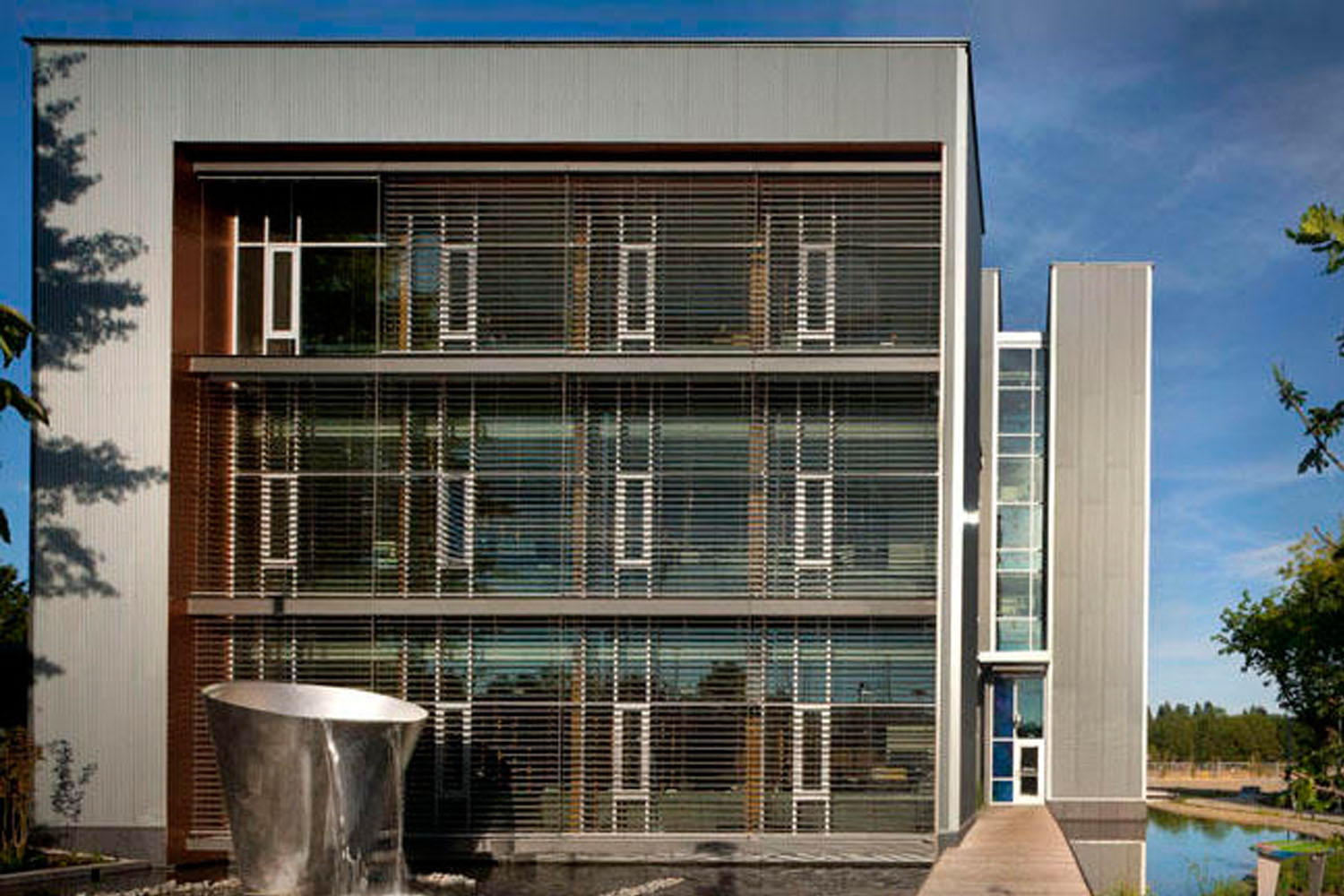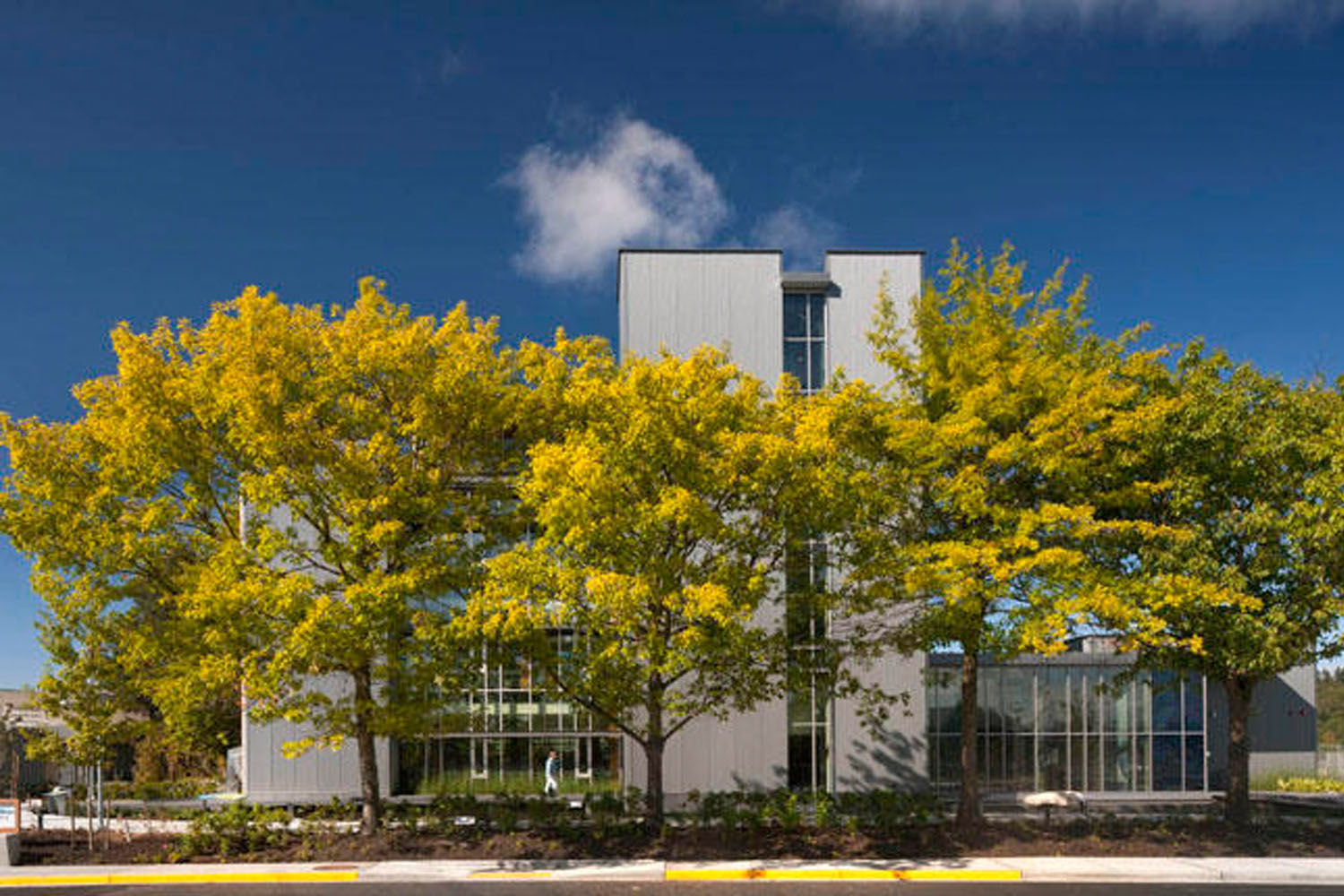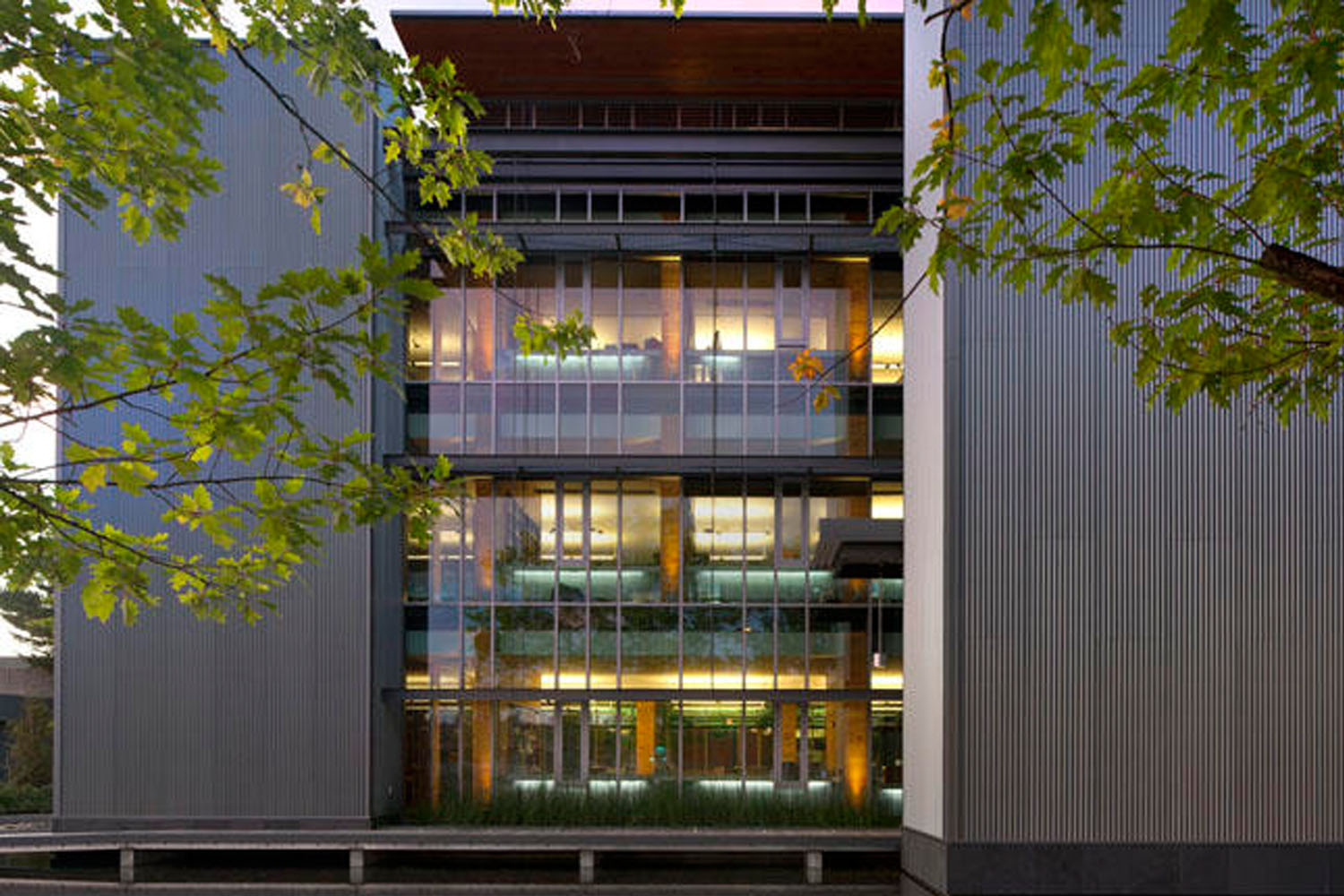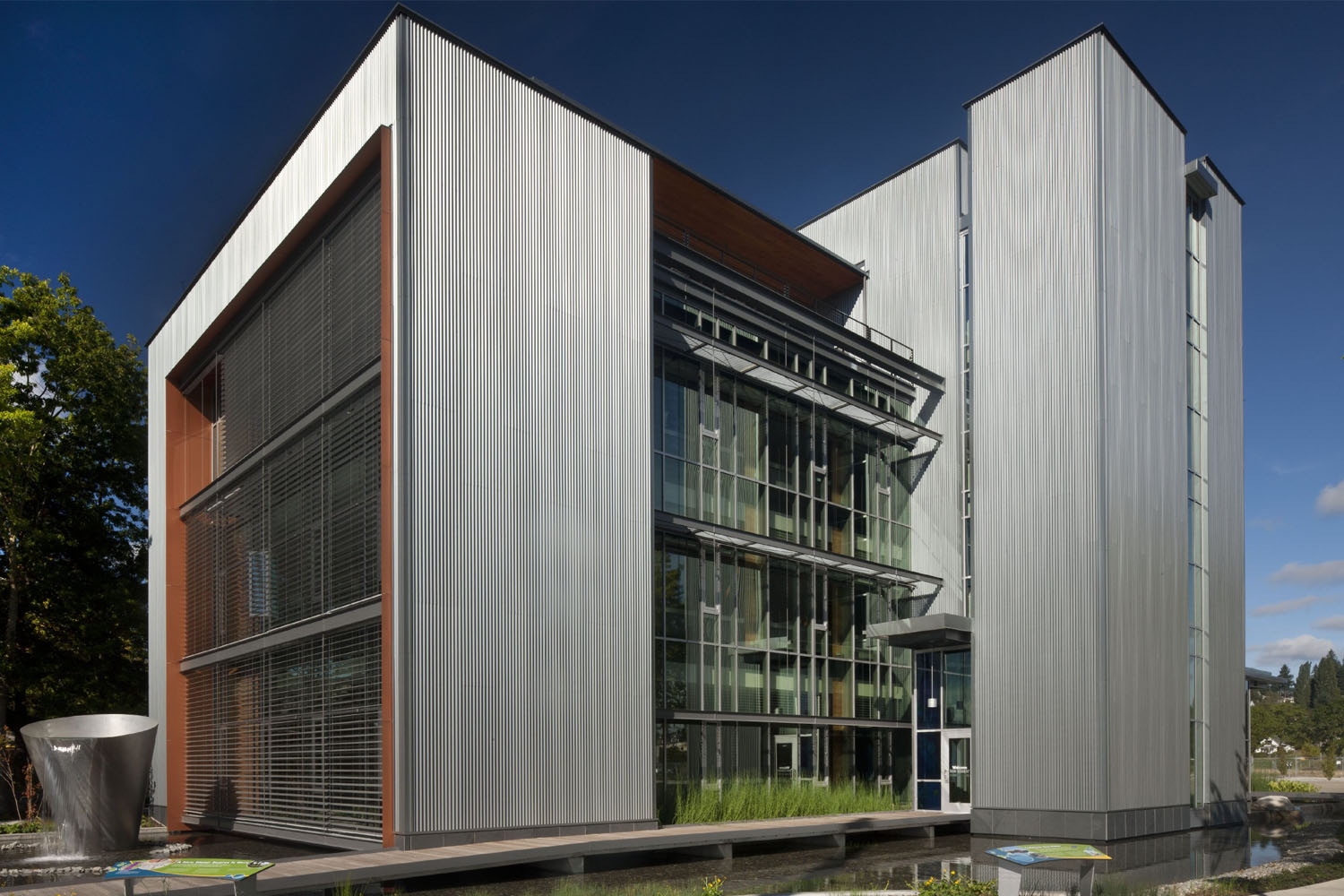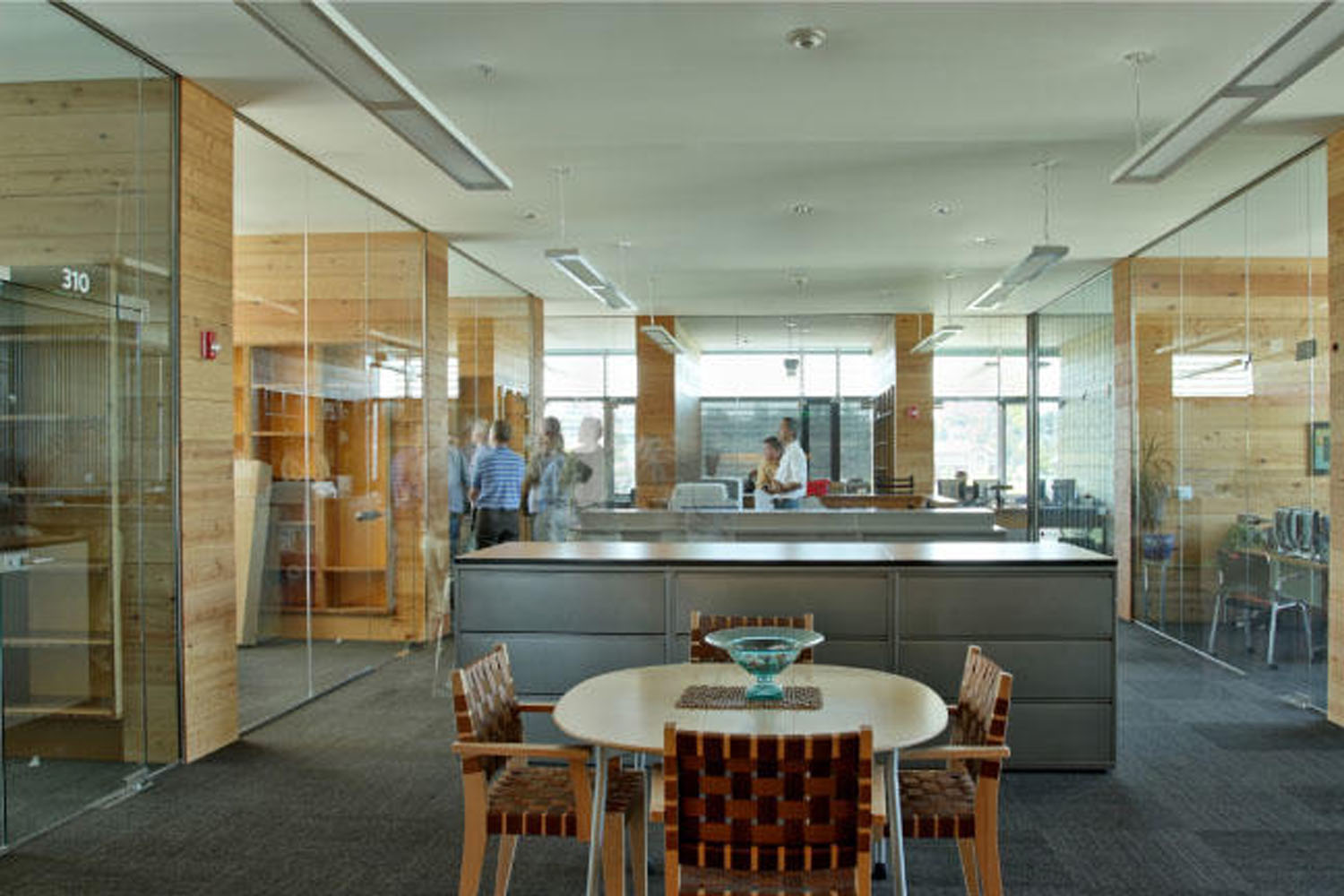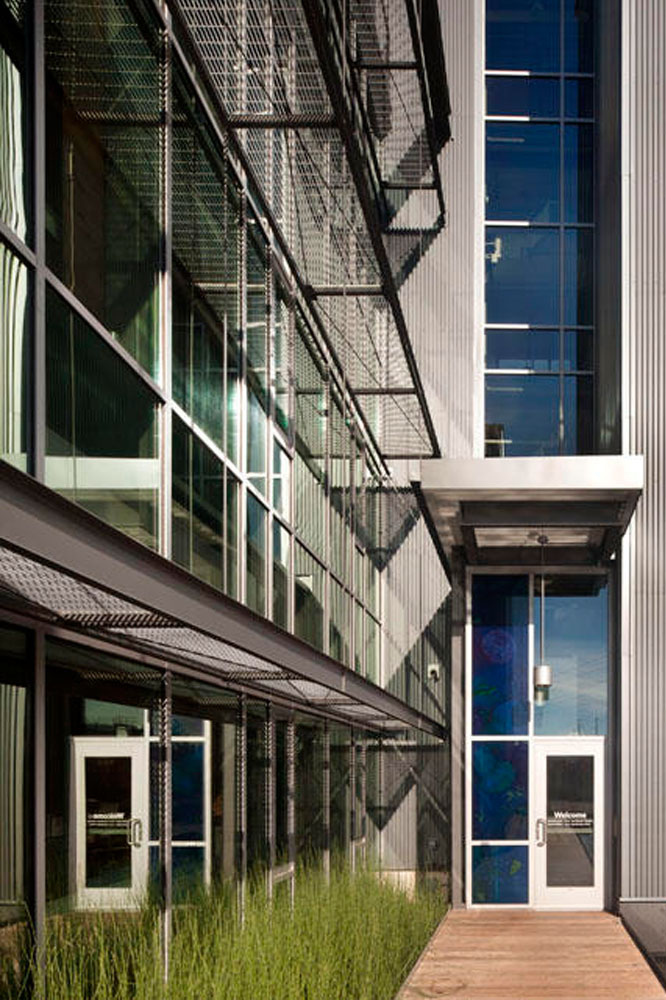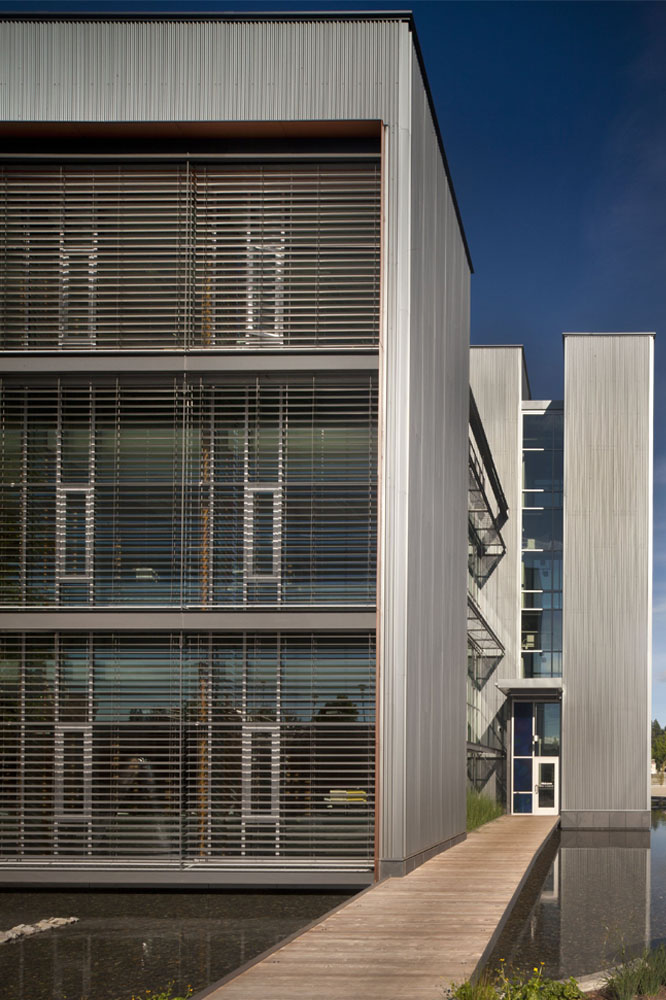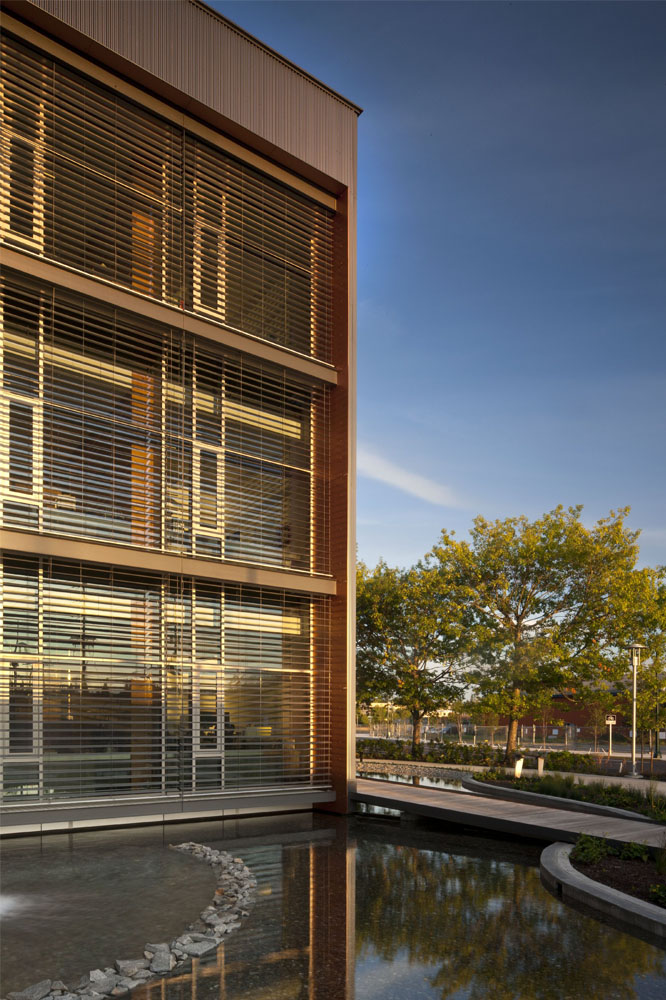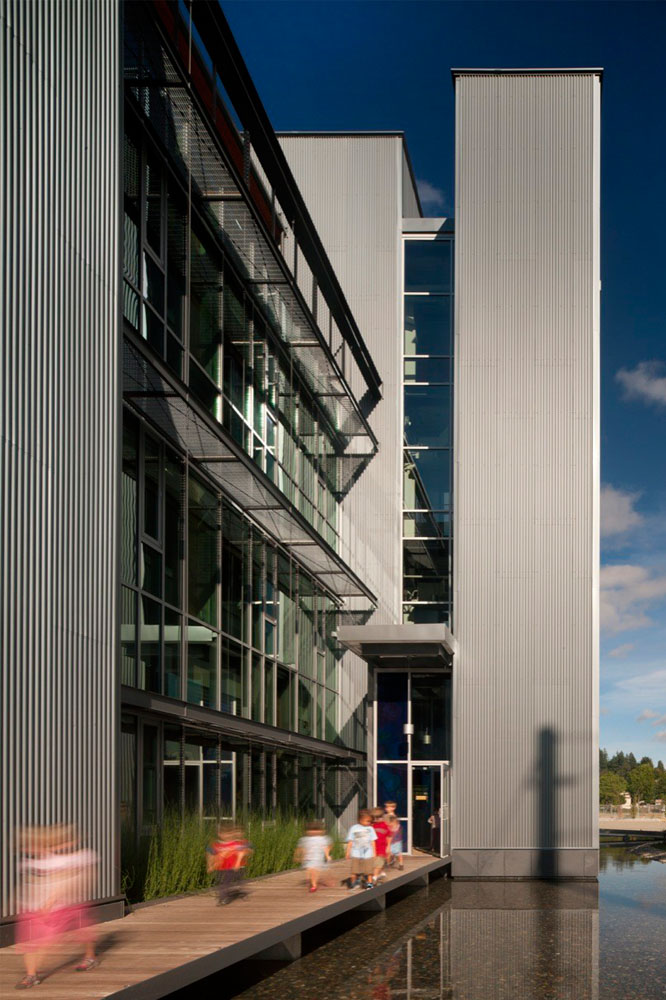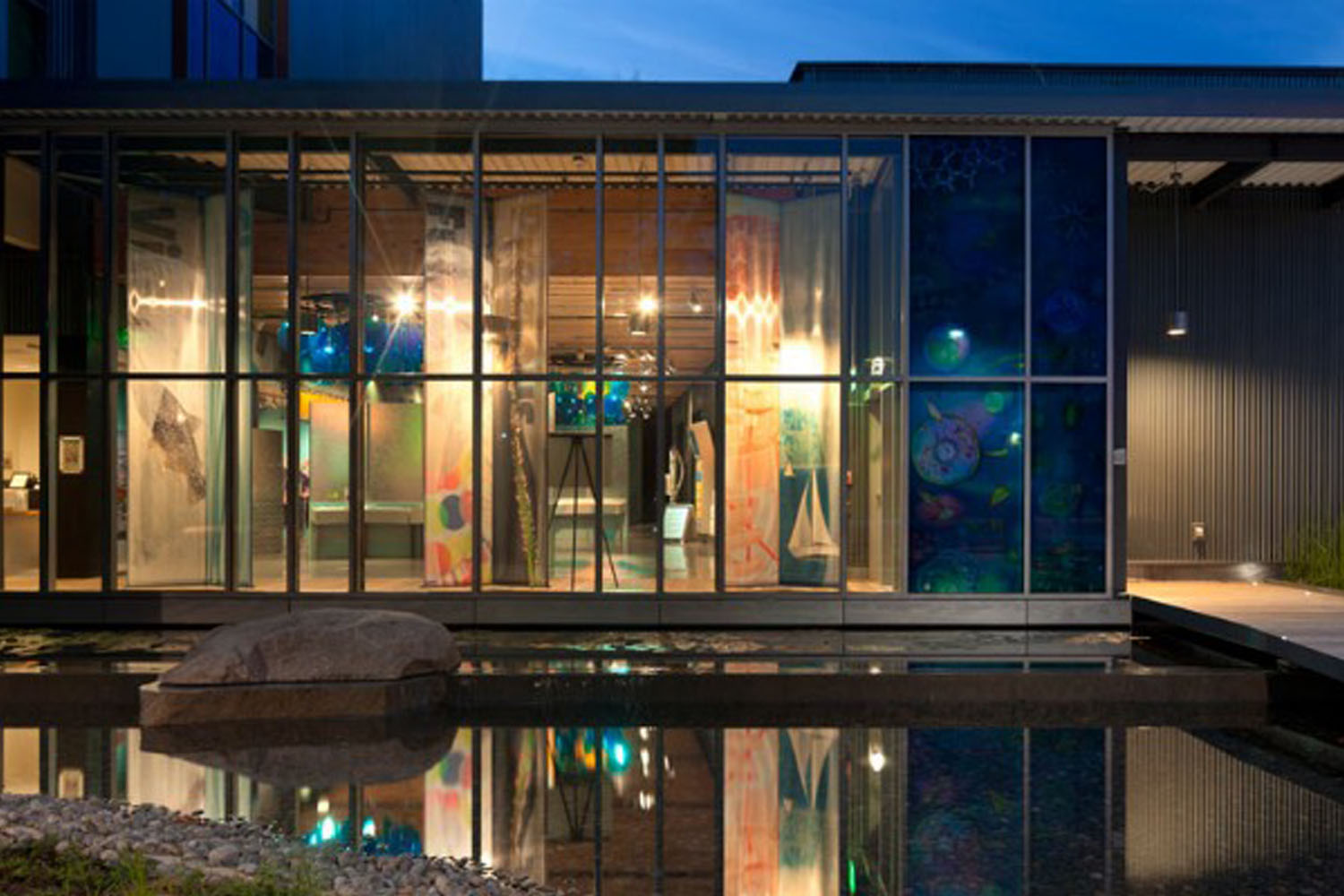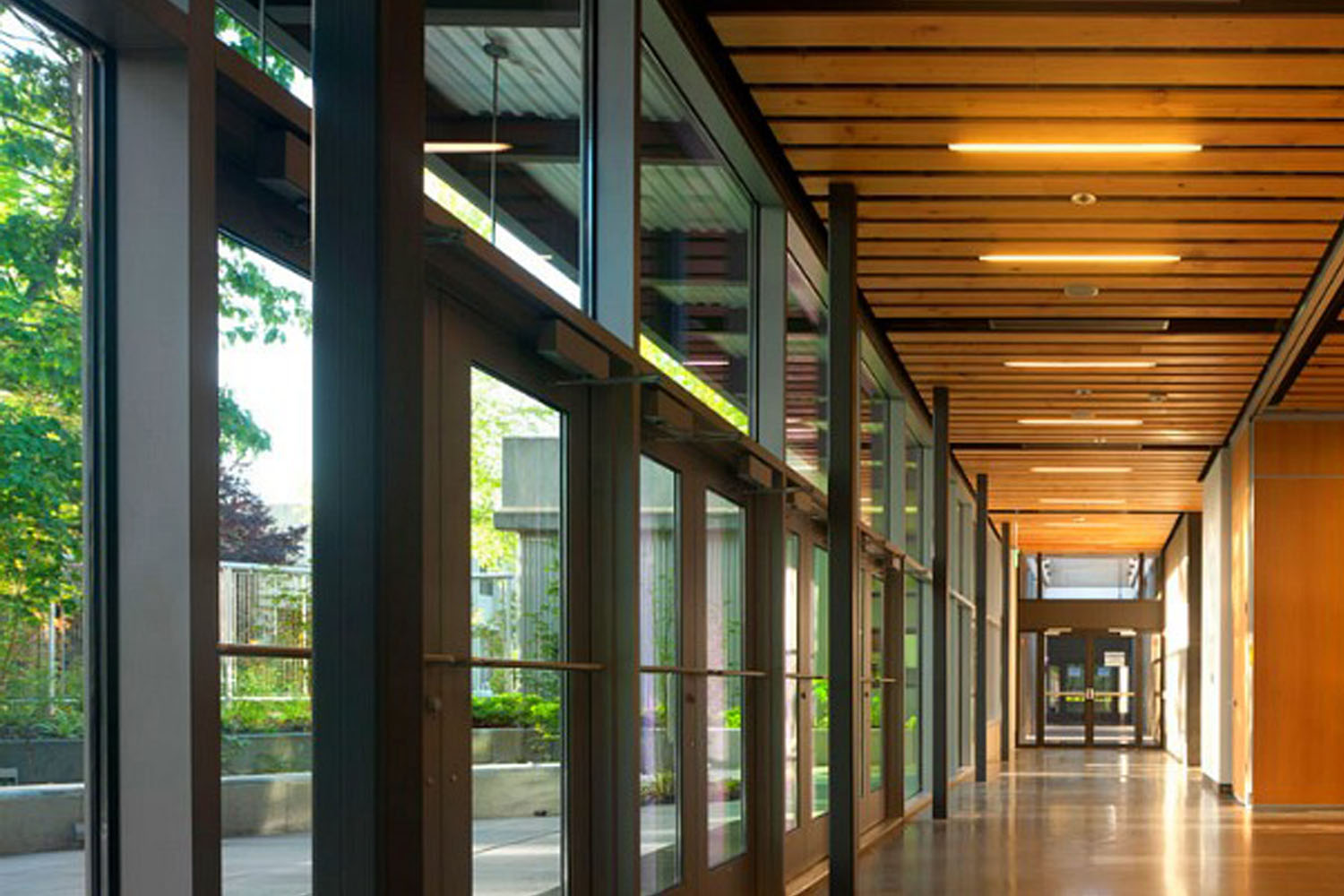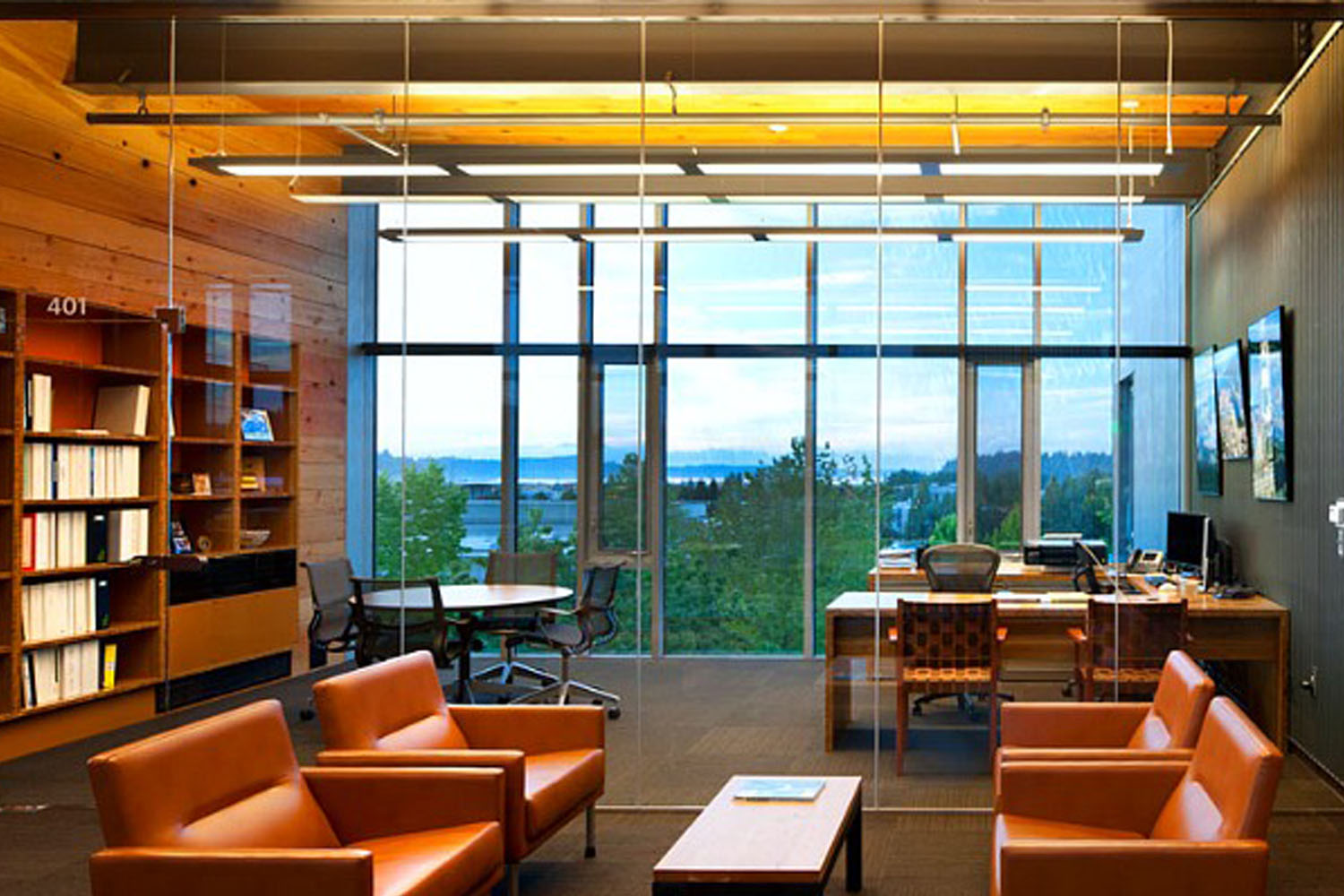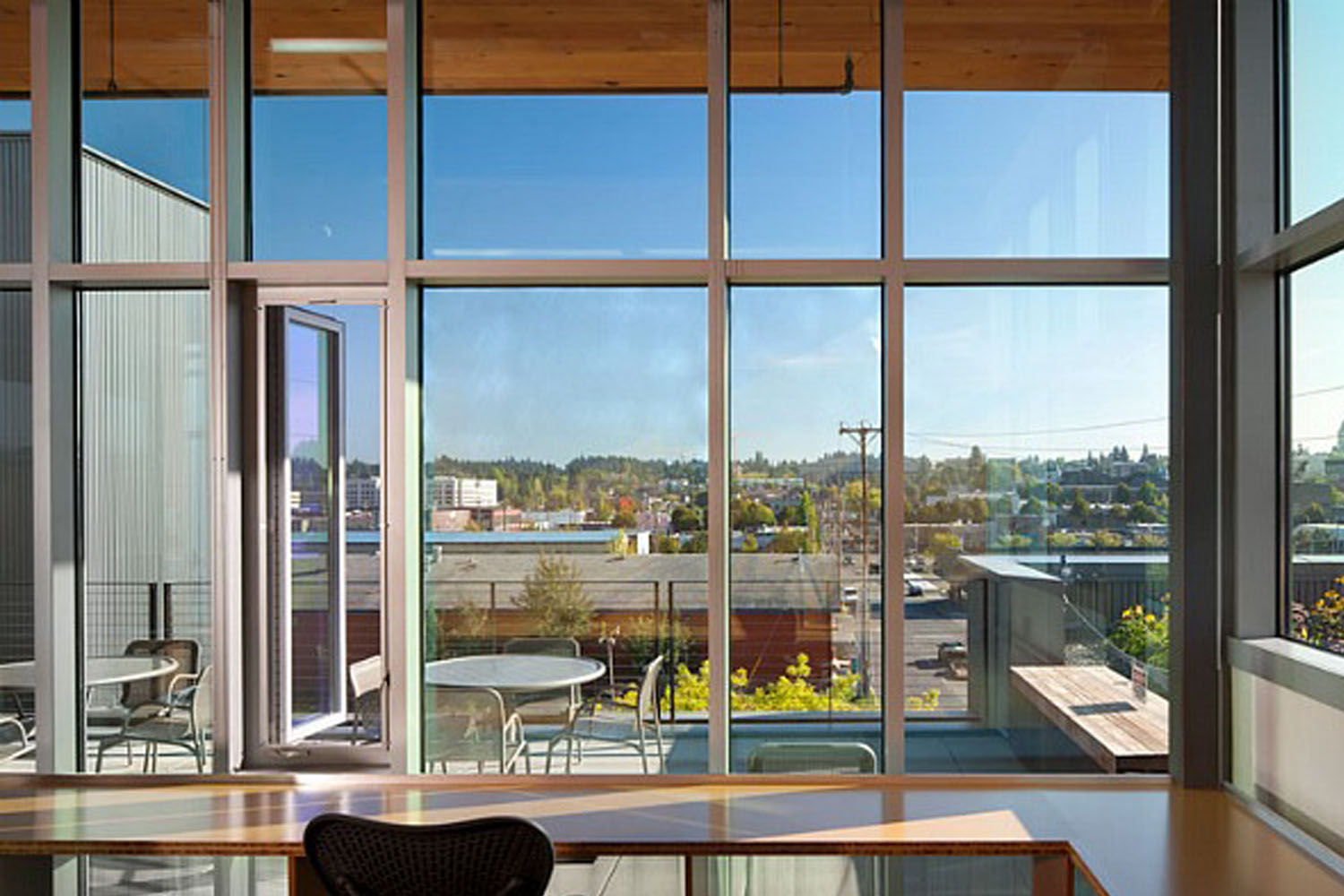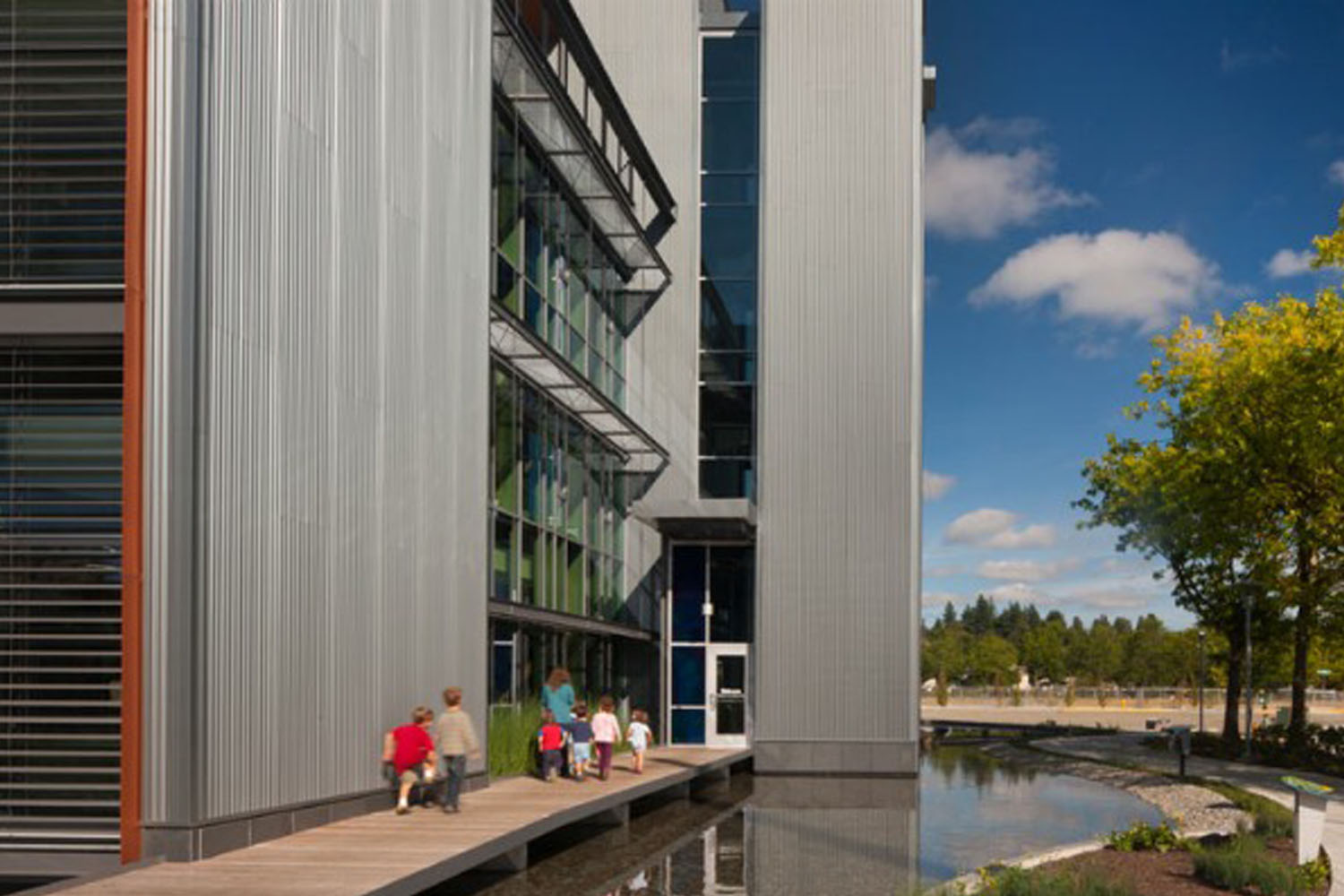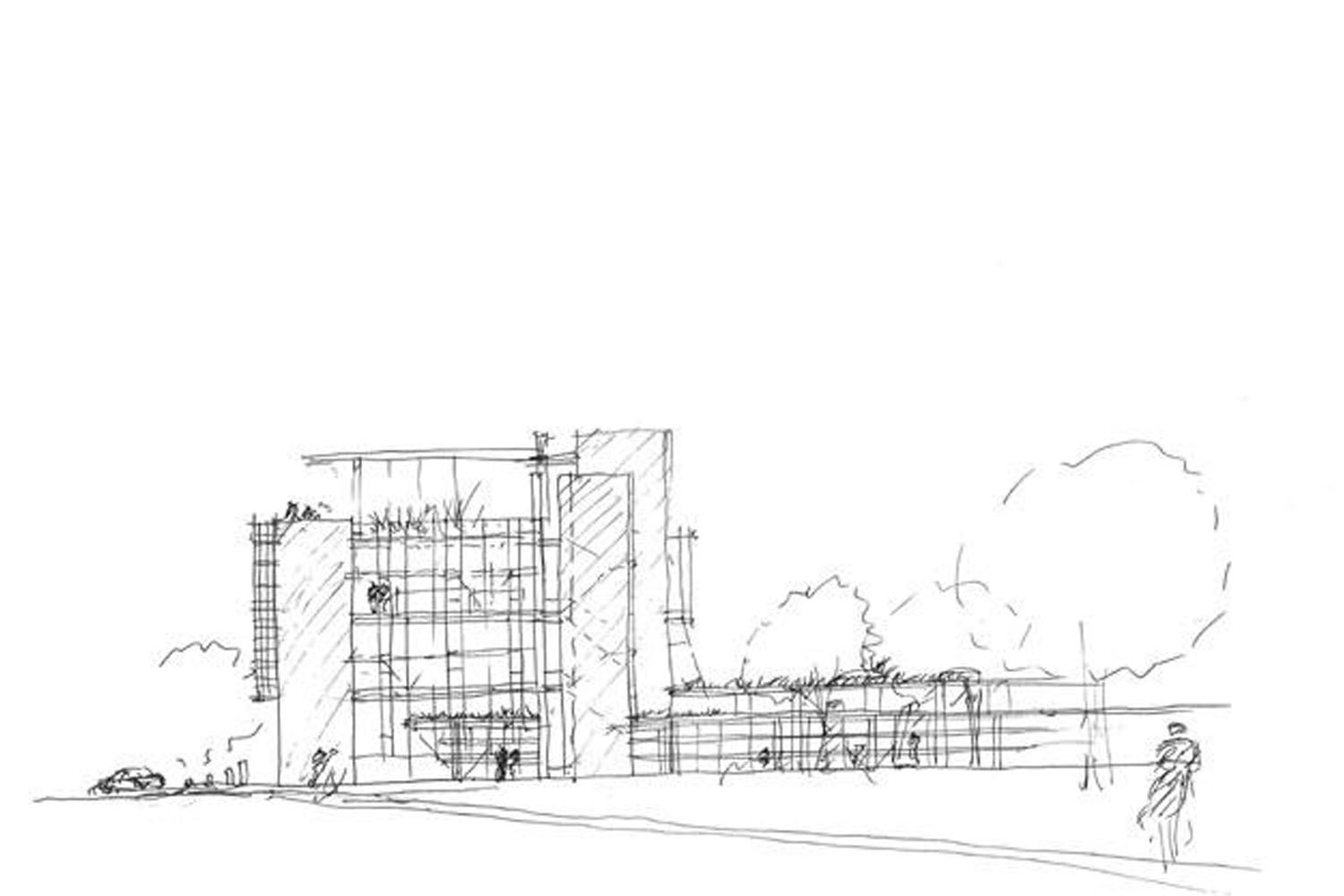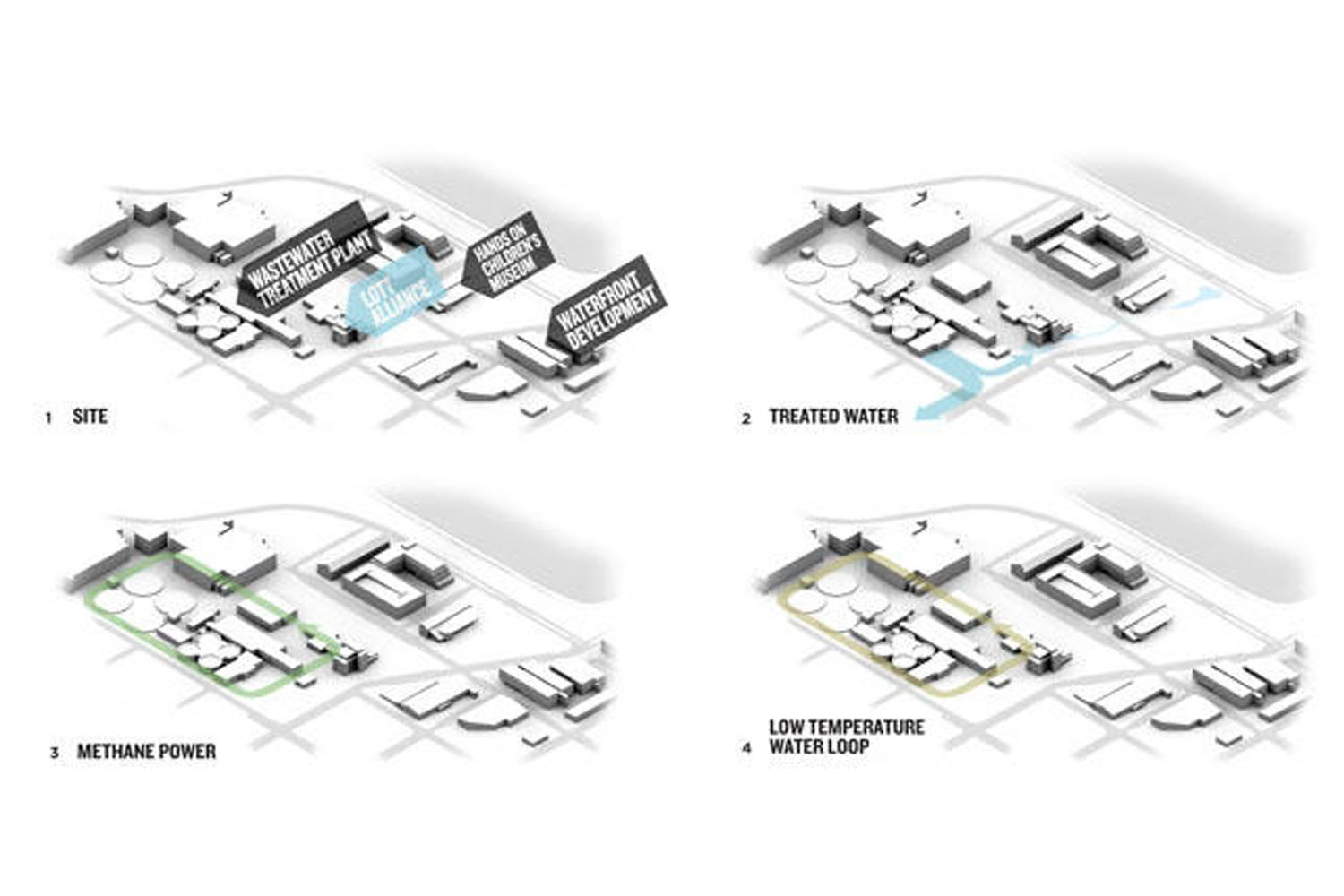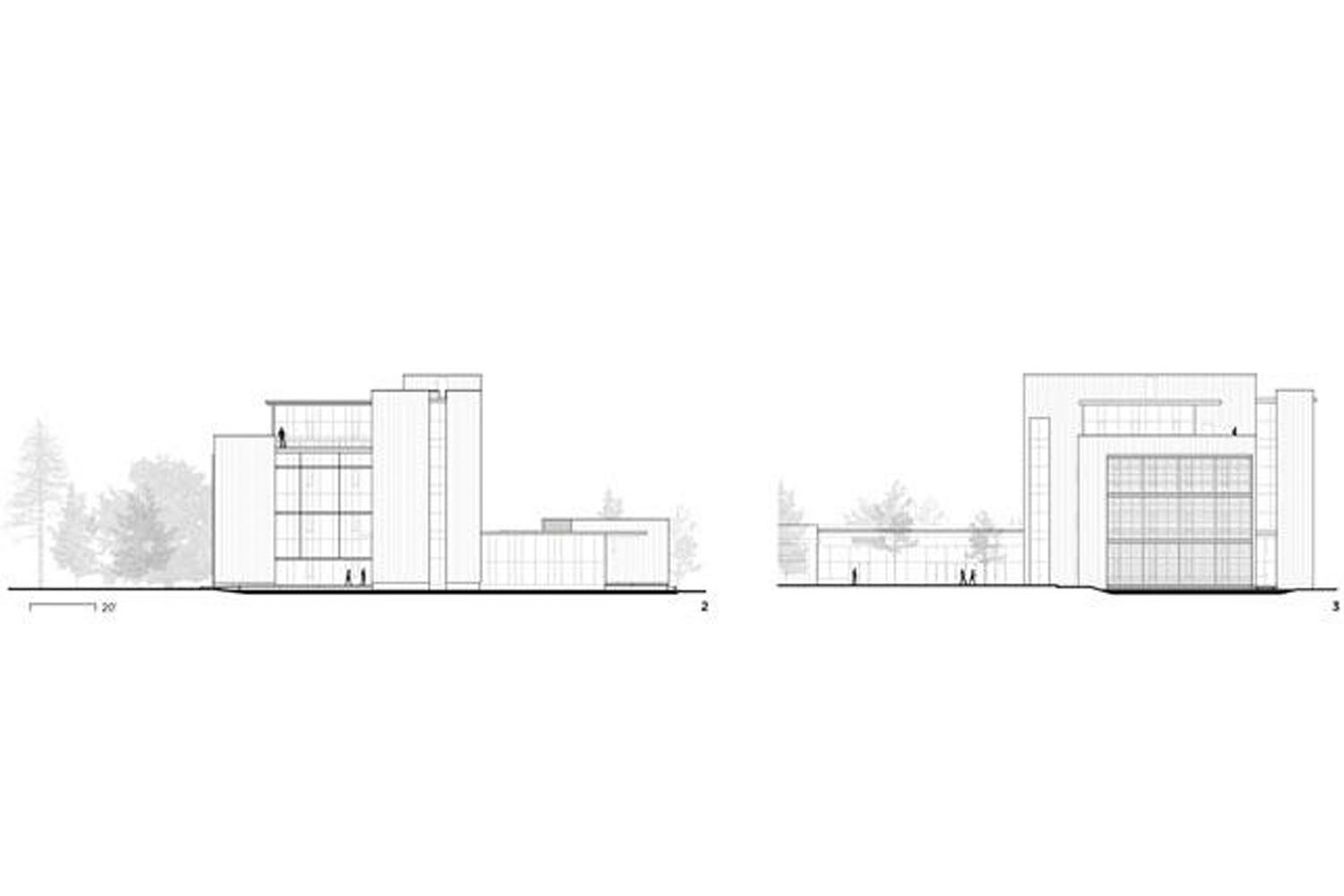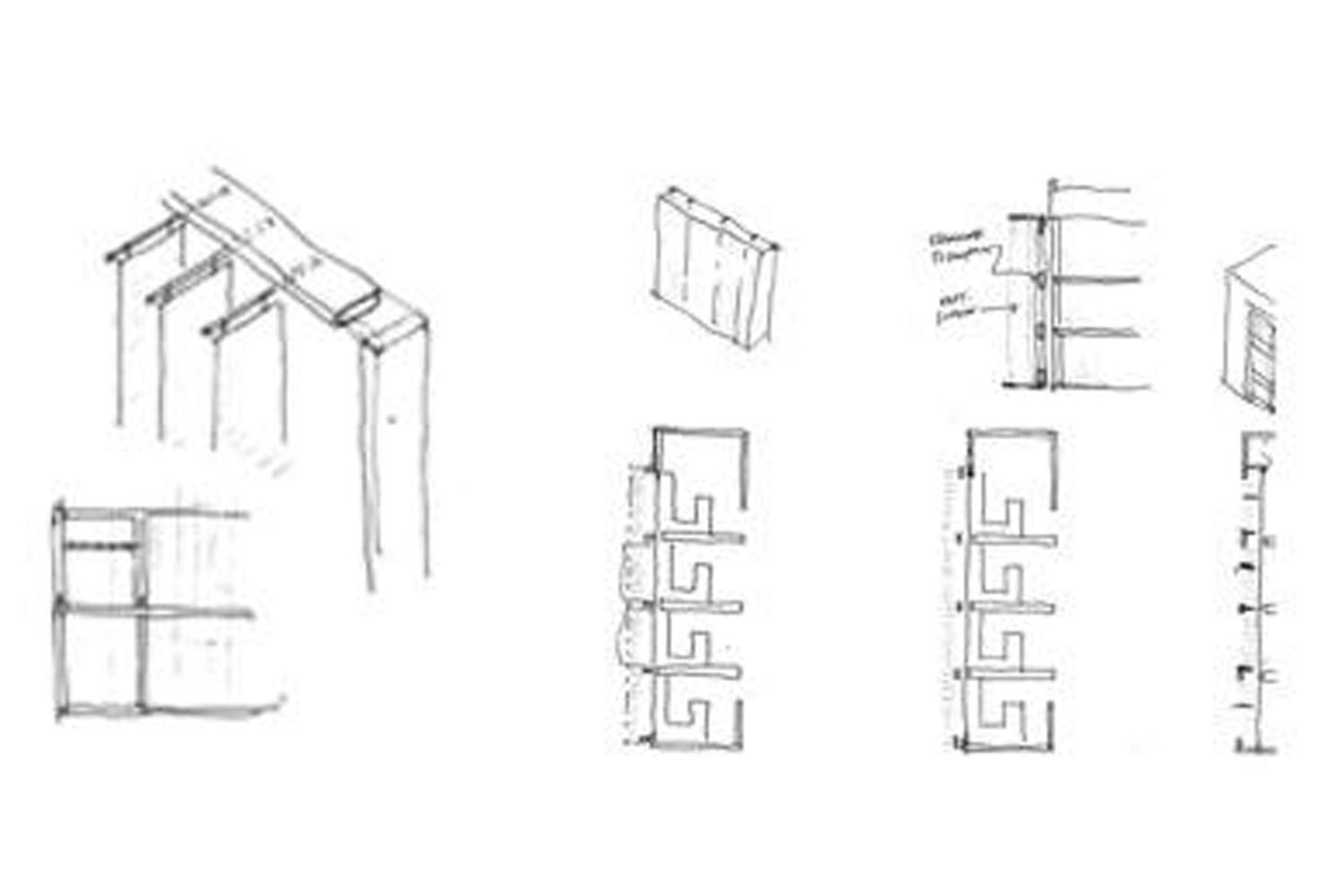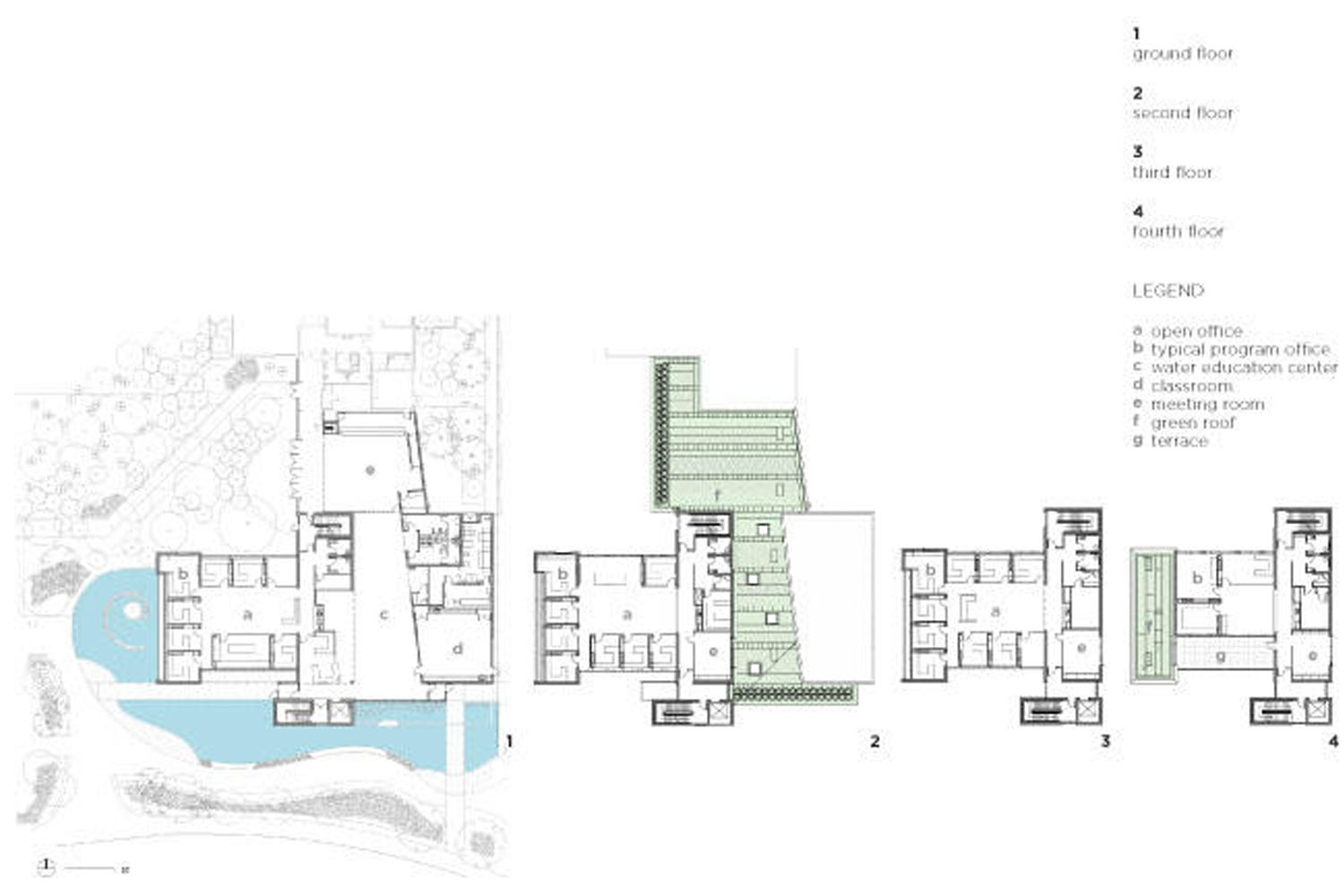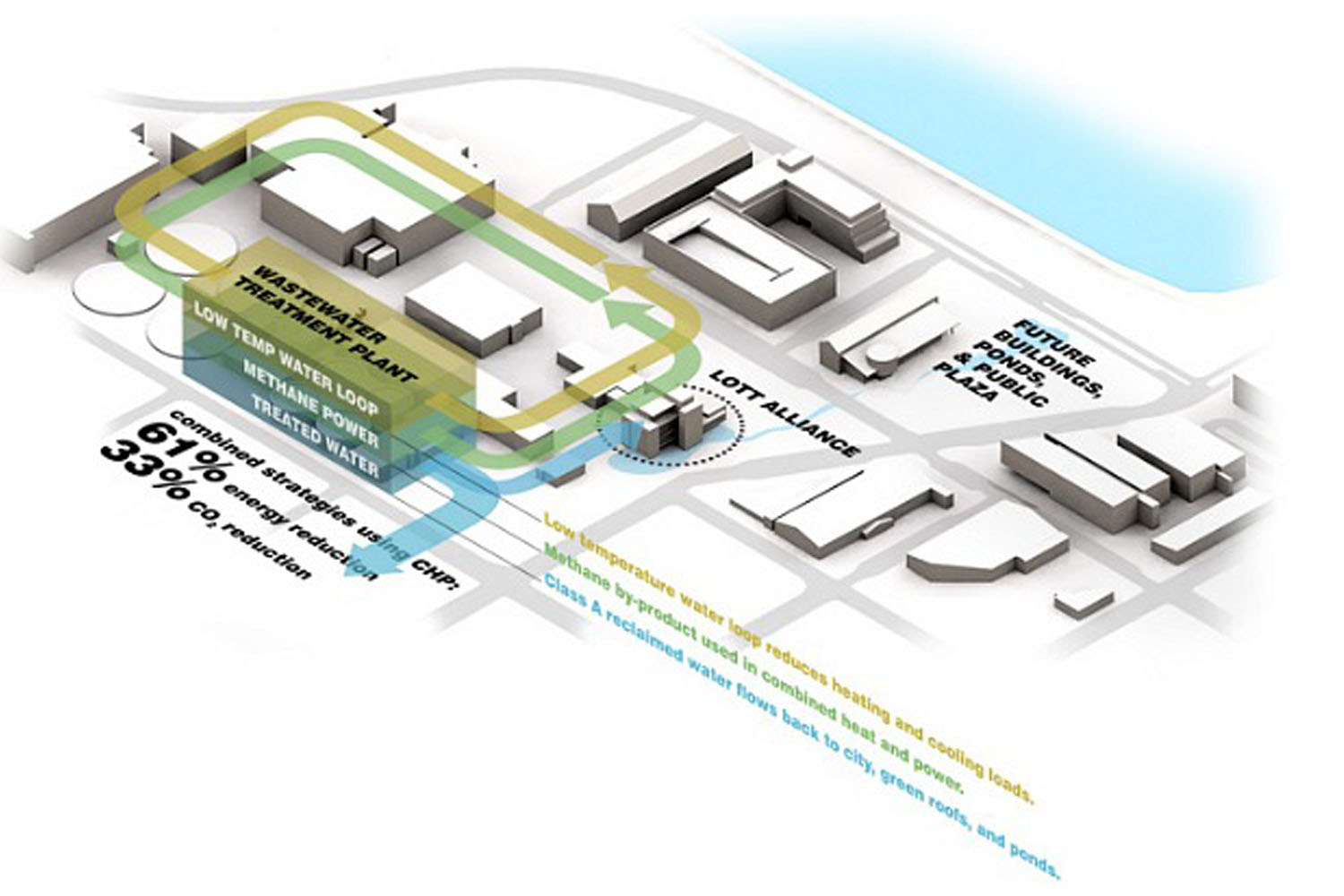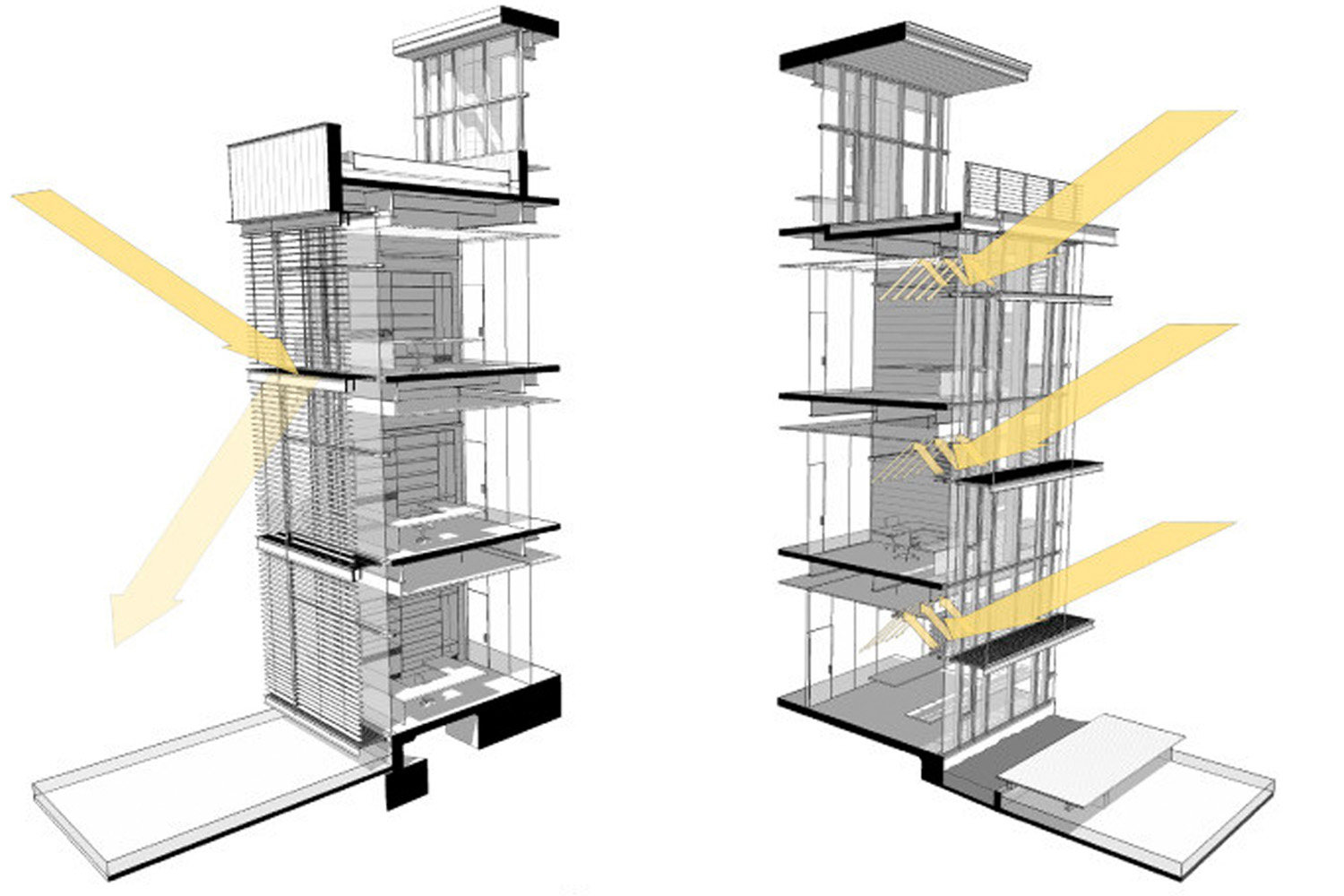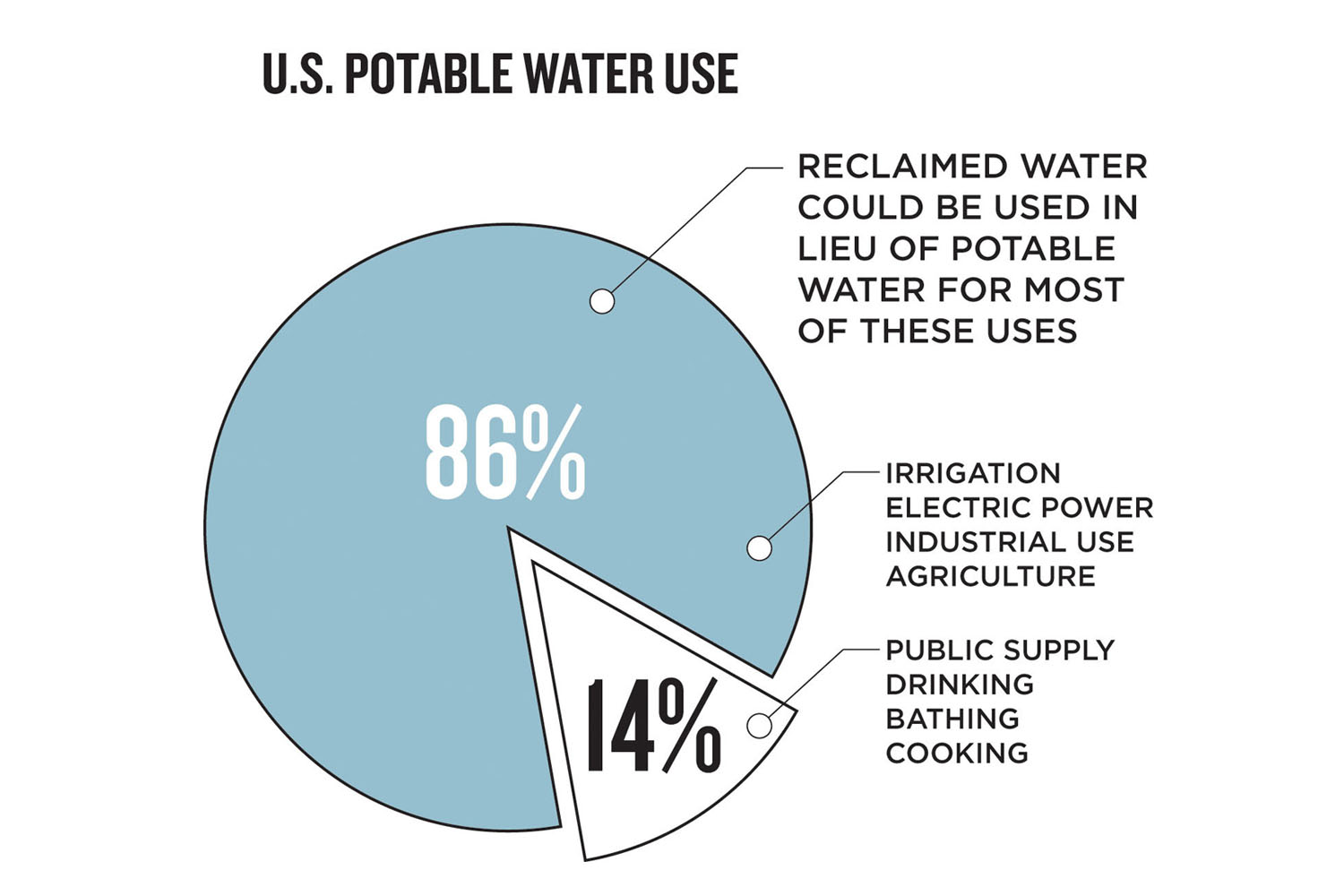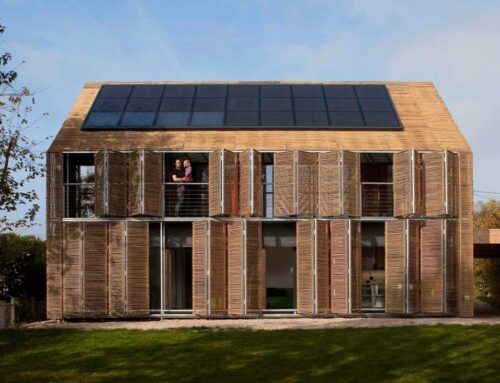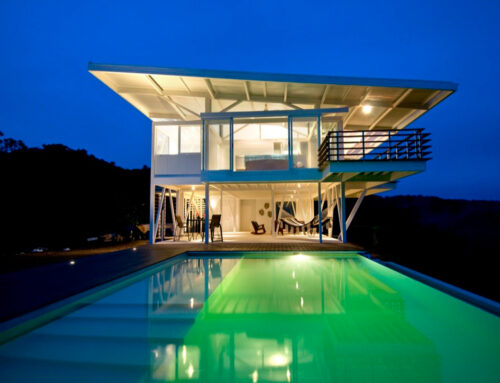مرکز خدمات منطقهای اتحادیهی آب پاک اِل.اُ.تی.تی اثر گروه میلِر هال، نوشتهی لادن مصطفیزاده
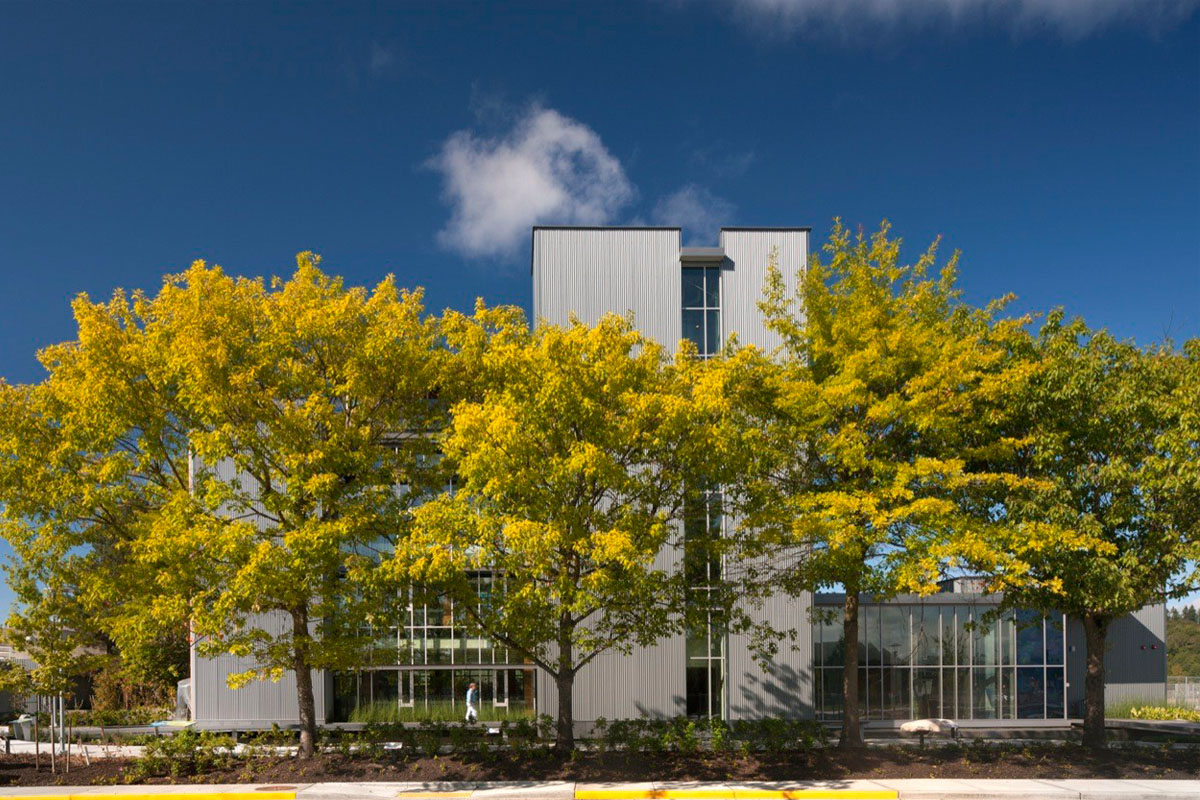
مرکز خدمات منطقهای اتحادیهی آب پاک اِل.اُ.تی.تی
گروه میلِر هال (Miller Hull) در سال 1977 توسط دِیوید میلِر (David Miller) و رابِرت هال (Robert Hull) تاسیس شده است. گروه میلِر هال پروژههای خود را با تمرکز بر اصول پایداری پیش میبرد و تاکنون جوایز زیادی را دریافت کرده است. طراحی مرکز خدمات منطقهای اتحادیهی آب پاک اِل.اُ.تی.تی (LOTT) یک تصفیهخانهی فاضلاب است که توسط گروه میلِر هال طراحی و موفق به دریافت گواهینامهی پلاتینویوم لید (LEED Platinum)، موفق به دریافت جایزهی “AIA Seattle” در سال 2011 و 2012 شده است و همچنین به عنوان یکی از ده پروژهی سبز در سی.اُ.تی (COTE) در سال 2011 معرفی شده است.
چالش طراحی این پروژه شامل نوسازی ساختمان اداری و آزمایشگاهی موجود و ایجاد یک مرکز خدمات منطقهای جدید چهارطبقه برای استقرار دفاتر اداری، مرکز عملیات اضطراری و اتاق هیات مدیره و یک مرکز آموزشی (شامل نمایشگاهها و یک کلاس درس) بود. اِسکات وُلف (Scott Wolf) یکی از شرکای میلِر هال است و میگوید: “تاسیسات جدید نمونهای ملموس از اصول پایداری است که سازمان اِل.اُ.تی.تی (LOTT) را هدایت و به عملیات کارآمد و برنامههای آموزشی آن کمک میکند. در حالیکه اکثر تصفیهخانههای فاضلاب در سراسر کشور توسط یک حصار زنجیرهای از جوامع خود جدا شدهاند اما اِل.اُ.تی.تی (LOTT) فعالانه مردم را درگیر میکند.
آب بازیافتی کلاس اِی (A) که در تصفیهخانه تولید میشود، آبی است که استفاده شده و سپس با استانداردهای با کیفیت بالا بازیافت شده است تا بتوان آن را به جامعه برگرداند و از آن برای آبیاری، شستشوی توالت، موارد صنعتی و تولیدی و بسیاری مصارف دیگر استفاده کرد. از مزایای آن میتوان به مواردی چون مدیریت فاضلاب و تامین آب و بهبود محیط زیست مانند استفاده از آب بازیافتی برای احیای تالابها یا افزایش جریان رودخانه اشاره کرد. آب بازیافت شده از تاسیسات جدید اِل.اُ.تی.تی (LOTT) برای حوضچهای که مرکز را احاطه کرده، آبیاری محوطه و بام سبز ساختمان و شست و شوی توالت در داخل ساختمان استفاده میشود. این ساختمان که با متناسب با اصول زیباییشناسی معاصر و صنعتی طراحی شده است، به منظور تکمیل محیط اطراف خود در نظر گرفته شده است، در حالیکه ارتفاع سازه به عنوان نمادی برای محله عمل میکند. این مرکز با دیگر پروژههای طراحی شده توسط میلِر هال در این منطقه که در حال ساخت هستند و همینطور میدان عمومی ایستبَی (East Bay) هماهنگ شده است.
رابِرت هال یکی از موسسین میلِر هال در مورد این ساختمان میگوید: “این ساختمان جدید همه چیزهای خوب در مورد مباشرت جامعه را به تصویر میکشد. این دیگر فقط یک تصفیهخانهی فاضلاب نیست بلکه به چهرهی عمومی جدید اِل.اُ.تی.تی (LOTT) در جامعه، تبدیل میشود”.
یک مجسمهی فوارهی آب شبیه یک فنجان بزرگ، آب بازیافت شده را به داخل حوض منتقل میکند، یک سیگنال بصری و شنیداری برای عموم ایجاد میکند و به طور نمادین آب تصفیهشده را برای استفادهی مجدد به جامعه باز میگرداند. آب در حوض به آرامی در اطراف ساختمان به سمت شرق حرکت میکند. لبههای حوض با گیاهان پوشیده شده و حوض کوچکتری در آبنمای بزرگتر از نیلوفرهای آبی پوشیده شده است. آب حوض بازیافت میشود و برای حفظ خود به حداقل آب نیاز دارد. دو مسیر پیادهروی بر روی حوض ساخته شد که مردم را به ورودیهای ساختمان هدایت میکند. سایر عناصر پایدار پروژه شامل استفادهی مجدد از الوارهای تخریبشده در نزدیکی سایت است که در ساخت انبار مورد استفاده قرار گرفتهاند. مصرف انرژی برای پروژه 50 درصد کمتر از یک ساختمان معمولی است که منجر به صرفهجویی قابل توجهی در هزینه در طول عمر آن میشود. نور طبیعی در فضاهای اداری، نیاز به نور مصنوعی را در بیشتر ساعات روز کاهش میدهد یا از بین میبرد. در نهایت، پنجرههای خارجی، نور خورشید را کنترل میکنند و بهرهی خورشیدی را به حداقل میرسانند که این امر نیاز به تهویهی مطبوع را کاهش میدهد.
معماری معاصر جهان: خدماتی
_______________________________________
نام پروژه: مرکز خدمات منطقهای اتحادیهی آب پاک اِل.اُ.تی.تی
عملکرد: خدماتی
شرکت-دفتر طراحی: گروه میلِر هال
تاریخ شروع و پایان ساخت: 2010
LOTT Clean Water Alliance Regional Services Center / Miller Hull Partnership
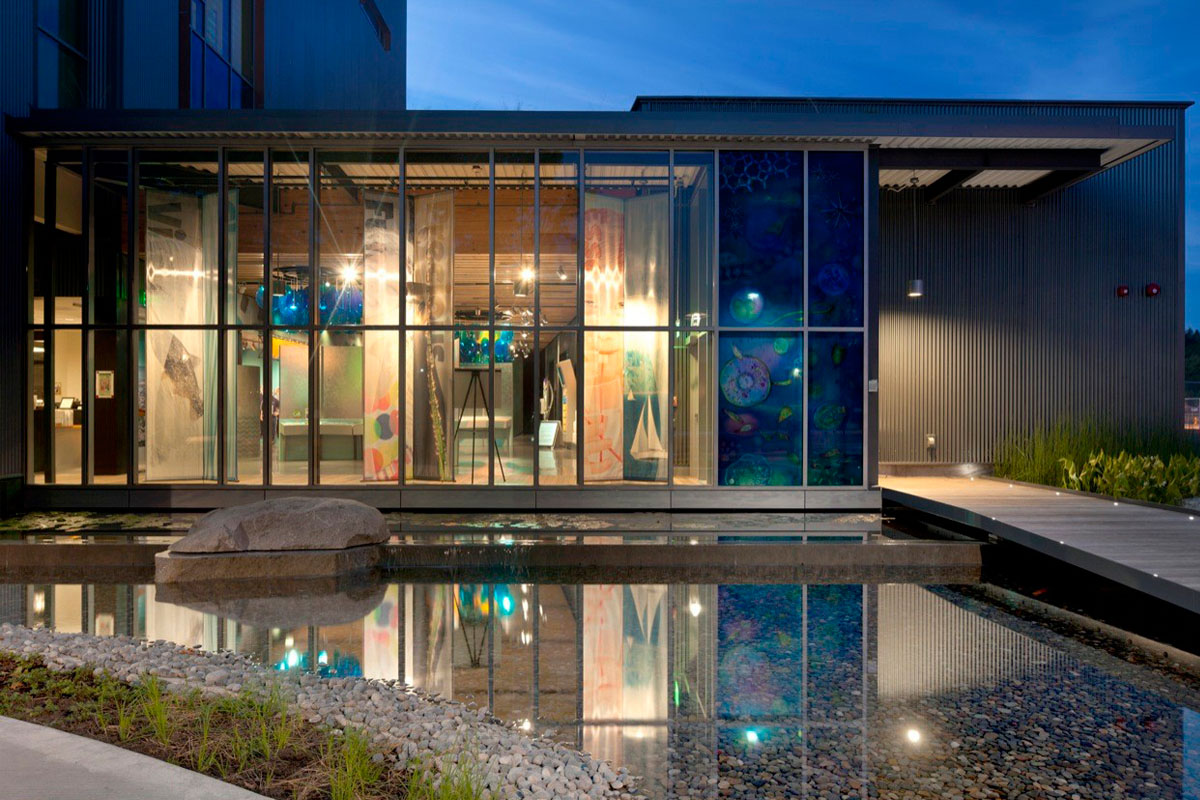
Project Name: LOTT Clean Water Alliance Regional Services Center
Function: Service
Architects: Miller Hull Partnership
Year: 2010
LOTT Clean Water Alliance Regional Services Center
The LOTT Clean Water Alliance Regional Services Center designed by the Miller Hull Partnership is a LEED Platinum certified wastewater treatment plant and recently named a COTE 2011 Top Ten Green Project. The design challenge for the project included renovating the existing administrative and laboratory building, and the creation of a new four-story Regional Services Center to house administrative offices, an emergency operations center, and boardroom, and an education center with interpretive exhibits and a classroom. “The new facility is a tangible example of the sustainable principles that guide the LOTT organization and fuel their efficient operations and education programs,” said Scott Wolf, partner at Miller Hull. While most wastewater treatment plants around the country are separated from their communities by a chain link fence, LOTT actively engages the public. Class A reclaimed water, produced at the treatment plant, is water that has been used and then cleaned to high quality standards so it can be returned to the community for irrigation, toilet flushing, industrial and manufacturing, and many other uses. Benefits include wastewater and water supply management, and environmental enhancement such as using reclaimed water for wetlands restoration or streamflow augmentation. The reclaimed water for LOTT’s new facility is used for a pond surrounding the center, for irrigating the grounds and the building’s green roof, and for toilet flushing inside the building. Designed with a contemporary, industrial aesthetic, the building is meant to complement its surroundings, while the structure’s height acts like an iconic symbol for the neighborhood. The facility is coordinated with other projects planned in the area, including a new Hands on Children’s Museum—also designed by Miller Hull—currently under construction, and the East Bay Public Plaza. “This new building portrays all the good things about community stewardship,” said Robert Hull, one of the founding partners of Miller Hull. “It’s no longer just a sewage treatment plant. It becomes the new public face of LOTT in the community.” A water fountain sculpture resembling a large cup pours reclaimed water into the pond and creates a visual and audible signal to the public, symbolically returning the treated reclaimed water to the community for reuse. The water in the pond moves slowly around the front of the building to the east. The edges of the pond are lined with plants, and a smaller pond within the larger water feature supports water lilies. The pond’s water is recycled, requiring minimal make-up water to sustain the pond. Two walkways were constructed over the pond leading people to the building entrances. Other sustainable elements of the project include reused timbers from a port warehouse that was demolished near the site. The energy use for the project is 50 percent less than of a typical building resulting in significant cost savings over its lifetime. Natural light in the office spaces reduces or eliminates the need for artificial lighting during most of the day. Lastly, external louvers control sunlight and minimize solar gain which further reduces the need for air conditioning.
مدارک فنی
جوایز
AIA Seattle, 2012 What Makes It Green
AIA COTE | Committee on the Environment, 2011 Top Ten Green Projects
AIA Seattle, 2011 Honor Award
منابع و ماخذ
www.millerhull.com
www.aiatopten.org
www.archdaily.com
archello.com
inhabitat.com

